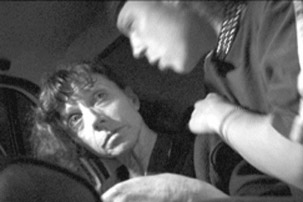
‘Night, Mother
Written by Genevieve Butler | Posted by: Anonymous
The drugs are what make mother and son duo Stephanie and Tony a bit of a family of three in the documentary "Foo-Foo Dust." They live with them, they talk about them constantly — sometimes fondly and at others, scornfully — and they work only to support their addictions. Twenty-two year old Tony is a heroin addict. Stephanie is on methadone, but her drug of choice is crack. Tony describes his mother’s life at one point as containing three things: "Me, rock and her." His seems essentially the same, of course with junk, not rock, in second place.
The first shot marches down the streets of San Francisco’s Tenderloin District, the neighborhood where Stephanie and Tony live in a cheap hotel. Inside it is, as one might expect, a bit of a mess. Throughout the film, Stephanie is all but exclusively filmed in their room, with the exception of some brief footage of the two of them in a cab near the end. Tony appears in the room mainly just while he is feeding his addiction; the filmmakers also talk to him out on the street, and interview him in a parked car.
Once inside, the camera falls immediately on Stephanie, rummaging around the bed, yelling at Tony, trying to find a lighter for her pipe. She can’t find one that works. She yells, calling Tony just about every name in the book. She stops at "son of a" and decides instead on "idiot." She’s also pissed because Tony has come back with less than she expected — the money is gone but the rocks are tiny — she doesn’t think what he gave her is worth more than $1 each, but she says she gave him a $20. Tony has gone straight to the bathroom, to cook his junk with one leg in the tub. The camera does not stop or look away as he sticks the needle in his arm and shoots up. He leaves it in, shaking his arm for a moment. The viewer can look into his face and see his expression change, from kind of stunned to sleepy and relieved, before he passes out onto the bathroom floor, still with one leg in the tub.
The camera is unblinking, basically impartial, shifting from one speaker to another, resting on one of them for long periods as they act, react, talk and satiate their cravings. Rarely do the filmmakers wander around the room, inspecting littered floors or piles of junk as in so many fiction films with similar subjects, like "Trainspotting" and "Sid and Nancy." The viewer is forced to listen to Stephanie and Tony talk. There are a few divergences, however, but thankfully few. One shot peeks inside an uncovered pot on the stove, but the only other thing that appears to have piqued Levy and Johnson’s interest besides the people, is Stephanie’s artwork. Stephanie appears happy and childlike as she leafs through the pages of her sketchbook, showing her drawings to the filmmakers, pointing out her "signature squiggle dog," which looks exactly as it sounds, and appears on every page.
Also all but absent, are the voices of the filmmakers. The viewer might occasionally make out the tail end of a question — the most notable example is when they ask Tony about his overdose of the previous evening — but there is practically nothing in the way of the filmmaker’s words or opinions. And there’s certainly no "Every year in this country…" type of thing to be found. While Levy and Johnson do employ sound design, and have some text which provides the viewer with an update on Stephanie and Tony since the spring of 2002 shoot, their footage is free of voiceovers or text within the film. The words are essentially Stephanie and Tony’s own.
Stephanie talks about her past, but much less emotionally than Tony when he speaks about events of not long before. He said that he and his mother used to talk more, and that they used to get out of whatever room they lived in more. Then, he explained, she used to tell him stories about the old days, her hippie days, her time in college, but not lately. The moment Levy and Johnson captured in their film is not one of their greatest. Albeit Stephanie has been on disability along time before the film cameras entered their lives, and Tony’s old life of lots of money and a fiancé is over, still the viewer gets the impression that they had seen better days even as full-time drug addicts.
Tony describes his former life as a speed dealer as happy (he was working and engaged to be married) and complete with all the material tropes of success: hundreds of dollars a day, a surround sound system, and a plasma T.V. Before that, he was a skinhead. It was at that time that he accumulated a lengthy criminal record. Tony seems a bit more considerate lately, and his bemoaning of their lifestyle, although it’s just before passing out, seems somewhat sincere. But quitting is a difficult prospect; they have been living this way for Tony’s whole life. As a child, he would hide and wait for his mother, who has always "turned tricks" off and on, to finish with her clients. He heard them yell at her and beat her. However, at the very beginning of the film, Tony is at his most nostalgic when describing this time. Their accommodations were always terrible, the lifestyle was harsh and miserable, full of sights and sounds that disgusted him, but through it all, they had a special, nightly ritual. Every night Stephanie would brush her fingers over the boy’s eyelids — gently tickling them closed — saying she was sprinkling him with "foo-foo dust" to help him sleep. It worked every time.
It wasn’t long after that that they both started to rely on a different substance. And although the "foo-foo dust" had lost its magic, the film shows that their relationship is still quite close. Gina Levy had described her four-day shoot of Stephanie and Tony with Eric Johnson as "extremely intense." Those days for Stephanie and Tony must have also been difficult; in that time Tony had an overdose, and they were evicted from the hotel. They gathered their stuff and moved on. According to the text featured at the end, alongside Johnson’s photographs, things haven’t gotten any better. The filmmakers still keep up with their subjects, whom they have been working with for a long time. The project came out of Johnson’s still photographs of them, and they are currently still shooting Stephanie and Tony.
Gina Levy has just returned from the 2004 Sundance Film Festival where ‘Foo-Foo Dust’ was screened. She is a graduate of Harvard University, and her first film, ‘Ask Again Later,’ premiered at the Palm Springs Film Festival. She is based in L.A. She can be reached via email at: ginalevy@yahoo.com.
Eric Johnson is primarily a still photographer. He has shot documentary photographs in India, Morocco and Peru, as well as in the United States. He lives and works in Mexico City.
'Foo-Foo Dust' will be screened at the upcoming Florida Film Festival: www.floridafilmfestival.com. Gina Levy has just returned from the 2004 Sundance Film Festival where 'Foo-Foo Dust' was screened. She is a graduate of Harvard University, and her first film, 'Ask Again Later,' premiered at the Palm Springs Film Festival. She is based in L.A. She can be reached via email at: ginalevy@yahoo.com. Eric Johnson is primarily a still photographer. He has shot documentary photographs in India, Morocco and Peru, as well as in the United States. He lives and works in Mexico City.









